Submitted:
18 October 2023
Posted:
19 October 2023
Read the latest preprint version here
Abstract
Keywords:
1. Introduction
2. Materials and Methods
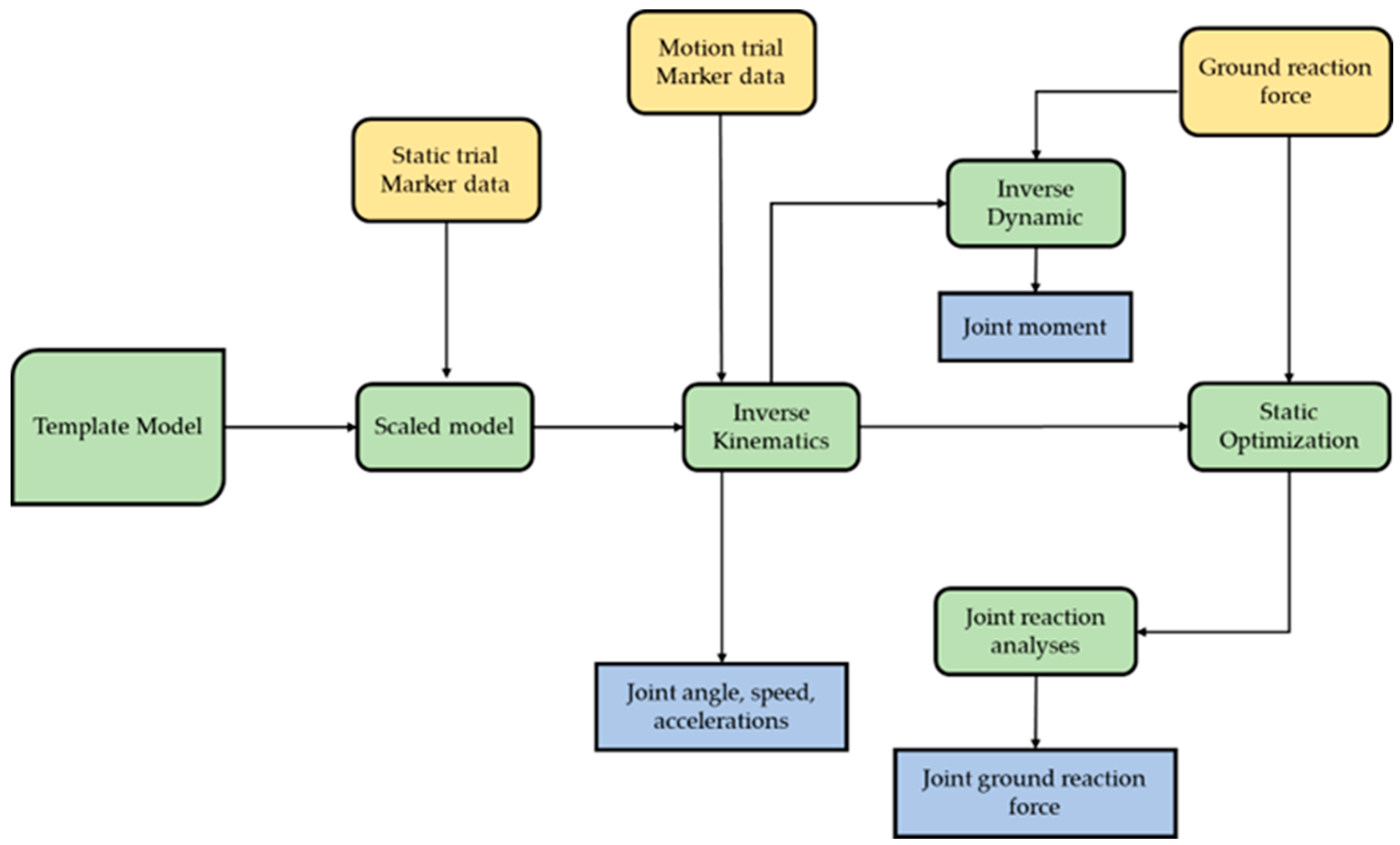
| Variables | ||
|---|---|---|
| IV | Jumping rope exercise | BB |
| HK | ||
| FB | ||
| SS | ||
| DV | Kinematics | Knee flexion (degree) |
| Knee moment (%BWm) | ||
| Kinetics | Knee joint GRF (%BW) | |
| Muscle forces (%BW) | ||
| IV, independent variables; DV, dependent variables; BB, basic bounce; HK, high knee jump; FB, forward-backward jump; SS, side-to-side jump; BW, body weight; BWm, Body weight∙hegiht(meter) | ||
3. Results
4. Discussion
5. Conclusions
Author Contributions
Funding
Institutional Review Board Statement
Informed Consent Statement
Data Availability Statement
Conflicts of Interest
References
- Abou Elmagd, M., Benefits, need and importance of daily exercise. Int. J. Phys. Educ. Sports Health, 2016. 3(5): p. 22-27.
- Afsar, E., et al., Use of the finite element analysis to determine stresses in the knee joints of osteoarthritis patients with different Q angles. Journal of the Brazilian Society of Mechanical Sciences and Engineering, 2017. 39: p. 1061-1067. [CrossRef]
- Agel, J., T. Rockwood, and D. Klossner, Collegiate ACL injury rates across 15 sports: national collegiate athletic association injury surveillance system data update (2004-2005 through 2012-2013). Clinical journal of sport medicine, 2016. 26(6): p. 518-523. [CrossRef]
- Alazzawi, S., et al., Management of anterior cruciate ligament injury: pathophysiology and treatment. British Journal of Hospital Medicine, 2016. 77(4): p. 222-225. [CrossRef]
- Ardern, C.L., et al., Return to sport following anterior cruciate ligament reconstruction surgery: a systematic review and meta-analysis of the state of play. British journal of sports medicine, 2011. 45(7): p. 596-606. [CrossRef]
- Bakker, R., et al., Effect of sagittal plane mechanics on ACL strain during jump landing. Journal of Orthopaedic Research, 2016. 34(9): p. 1636-1644. [CrossRef]
- Baumgart, C., et al., Do ground reaction forces during unilateral and bilateral movements exhibit compensation strategies following ACL reconstruction? Knee Surgery, Sports Traumatology, Arthroscopy, 2017. 25: p. 1385-1394. [CrossRef]
- Boden, B.P., et al., Mechanisms of anterior cruciate ligament injury. 2000, SLACK Incorporated Thorofare, NJ. p. 573-578. [CrossRef]
- Boden, B.P. and F.T. Sheehan, Mechanism of non-contact ACL injury: OREF Clinical Research Award 2021. Journal of Orthopaedic Research®, 2022. 40(3): p. 531-540. [CrossRef]
- Boden, B.P., et al., Non-contact ACL injuries: mechanisms and risk factors. The Journal of the American Academy of Orthopaedic Surgeons, 2010. 18(9): p. 520.
- Brazen, D.M., et al., The effect of fatigue on landing biomechanics in single-leg drop landings. Clinical Journal of Sport Medicine, 2010. 20(4): p. 286-292. [CrossRef]
- Carvalho, A., P. Mourão, and E. Abade, Effects of strength training combined with specific plyometric exercises on body composition, vertical jump height and lower limb strength development in elite male handball players: a case study. Journal of human kinetics, 2014. 41: p. 125. [CrossRef]
- Chen, L., et al., Effect of different landing actions on knee joint biomechanics of female college athletes: Based on opensim simulation. Frontiers in Bioengineering and Biotechnology, 2022. 10: p. 899799. [CrossRef]
- Cruz, A., et al., The effects of three jump landing tasks on kinetic and kinematic measures: implications for ACL injury research. Research in sports medicine, 2013. 21(4): p. 330-342. [CrossRef]
- Donath, L., et al., Effects of slackline training on balance, jump performance & muscle activity in young children. International journal of sports medicine, 2013: p. 1093-1098. [CrossRef]
- Donelon, T.A., et al., Biomechanical determinants of knee joint loads associated with increased anterior cruciate ligament loading during cutting: a systematic review and technical framework. Sports Medicine-Open, 2020. 6(1): p. 1-21. [CrossRef]
- Eler, N. and H. Acar, The Effects of the Rope Jump Training Program in Physical Education Lessons on Strength, Speed and VO 2 Max in Children. Universal Journal of Educational Research, 2018. 6(2): p. 340-345. [CrossRef]
- Etnoyer, J., et al., Instruction and jump-landing kinematics in college-aged female athletes over time. Journal of athletic training, 2013. 48(2): p. 161-171. [CrossRef]
- Fleming, B.C., et al., The effect of weightbearing and external loading on anterior cruciate ligament strain. Journal of biomechanics, 2001. 34(2): p. 163-170. [CrossRef]
- Fort-Vanmeerhaeghe, A., et al., Lower limb neuromuscular asymmetry in volleyball and basketball players. Journal of Human Kinetics, 2016. 50: p. 135. [CrossRef]
- Gardner, E.J., et al., Effect of anteromedial and posterolateral anterior cruciate ligament bundles on resisting medial and lateral tibiofemoral compartment subluxations. Arthroscopy: The Journal of Arthroscopic & Related Surgery, 2015. 31(5): p. 901-910. [CrossRef]
- Gerritsen, K.G., A.J. van den Bogert, and B.M. Nigg, Direct dynamics simulation of the impact phase in heel-toe running. Journal of biomechanics, 1995. 28(6): p. 661-668. [CrossRef]
- Gokeler, A., et al., Abnormal landing strategies after ACL reconstruction. Scandinavian journal of medicine & science in sports, 2010. 20(1): p. e12-e19. [CrossRef]
- Hansberger, B.L., et al., Peak lower extremity landing kinematics in dancers and nondancers. Journal of athletic training, 2018. 53(4): p. 379-385. [CrossRef]
- Hong, Y.G., et al., The kinematic/kinetic differences of the knee and ankle joint during single-leg landing between shod and barefoot condition. International journal of precision engineering and manufacturing, 2014. 15: p. 2193-2197. [CrossRef]
- Jang, K.H., et al., Effects of skill level and feet width on kinematic and kinetic variables during jump rope single under. Korean J. Sport Biomech, 2017. 27(2): p. 99-108. [CrossRef]
- Kar, J. and P.M. Quesada, A numerical simulation approach to studying anterior cruciate ligament strains and internal forces among young recreational women performing valgus inducing stop-jump activities. Annals of biomedical engineering, 2012. 40: p. 1679-1691. [CrossRef]
- Kar, J. and P.M. Quesada, A musculoskeletal modeling approach for estimating anterior cruciate ligament strains and knee anterior–posterior shear forces in stop-jumps performed by young recreational female athletes. Annals of biomedical engineering, 2013. 41: p. 338-348. [CrossRef]
- Kim, C., et al., Effects of patellofemoral pain syndrome on changes in dynamic postural stability during landing in adult women. Applied Bionics and Biomechanics, 2022. 2022. [CrossRef]
- Kim, H.J., et al., Evaluation of predicted knee-joint muscle forces during gait using an instrumented knee implant. Journal of orthopaedic research, 2009. 27(10): p. 1326-1331. [CrossRef]
- Kim, Y. and D. Kim, A Comparative Analysis on the Kinematic and Ground Reaction Force Factors by Rope Skipping Types. Korea Society for Wellness, 2015. 10(2): p. 77-77.
- Konrath, J.M., et al., Estimation of the knee adduction moment and joint contact force during daily living activities using inertial motion capture. Sensors, 2019. 19(7): p. 1681. [CrossRef]
- Leppänen, M., et al., Stiff landings are associated with increased ACL injury risk in young female basketball and floorball players. The American journal of sports medicine, 2017. 45(2): p. 386-393. [CrossRef]
- Lim, Y.P., Y.-C. Lin, and M.G. Pandy, Effects of step length and step frequency on lower-limb muscle function in human gait. Journal of biomechanics, 2017. 57: p. 1-7. [CrossRef]
- Lohmander, L.S., et al., The long-term consequence of anterior cruciate ligament and meniscus injuries: osteoarthritis. The American journal of sports medicine, 2007. 35(10): p. 1756-1769.
- Majewski, M., H. Susanne, and S. Klaus, Epidemiology of athletic knee injuries: A 10-year study. The knee, 2006. 13(3): p. 184-188. [CrossRef]
- Maniar, N., et al., Muscle force contributions to anterior cruciate ligament loading. Sports Medicine, 2022. 52(8): p. 1737-1750. [CrossRef]
- Marieswaran, M., et al., A review on biomechanics of anterior cruciate ligament and materials for reconstruction. Applied bionics and biomechanics, 2018. 2018. [CrossRef]
- Miyaguchi, K., S. Demura, and M. Omoya, Relationship between jump rope double unders and sprint performance in elementary schoolchildren. The Journal of Strength & Conditioning Research, 2015. 29(11): p. 3229-3233. [CrossRef]
- Miyaguchi, K., H. Sugiura, and S. Demura, Possibility of stretch-shortening cycle movement training using a jump rope. The Journal of Strength & Conditioning Research, 2014. 28(3): p. 700-705. [CrossRef]
- Neal, B.S., et al., Foot posture as a risk factor for lower limb overuse injury: a systematic review and meta-analysis. Journal of foot and ankle research, 2014. 7: p. 1-13. [CrossRef]
- Niu, W., et al., Effect of dropping height on the forces of lower extremity joints and muscles during landing: a musculoskeletal modeling. Journal of Healthcare Engineering, 2018. 2018. [CrossRef]
- Norcross, M.F., et al., The association between lower extremity energy absorption and biomechanical factors related to anterior cruciate ligament injury. Clinical biomechanics, 2010. 25(10): p. 1031-1036. [CrossRef]
- Nur Saibah, G., Biomechanical investigation of individual with over-pronation and over-supination foot during walking/Nur Saibah Ghani. 2020, University of Malaya.
- Oberländer, K.D., et al., Altered landing mechanics in ACL-reconstructed patients. Medicine and science in sports and exercise, 2013. 45(3): p. 506-513. [CrossRef]
- Orhan, S., Effect of weighted rope jumping training performed by repetition method on the heart rate, anaerobic power, agility and reaction time of basketball players. Advance in Environmental Biology, 2013. 7(5): p. 945-951.
- Orishimo, K.F., et al., Adaptations in single-leg hop biomechanics following anterior cruciate ligament reconstruction. Knee Surgery, Sports Traumatology, Arthroscopy, 2010. 18(11): p. 1587-1593. [CrossRef]
- Paterno, M.V., et al., Biomechanical measures during landing and postural stability predict second anterior cruciate ligament injury after anterior cruciate ligament reconstruction and return to sport. The American journal of sports medicine, 2010. 38(10): p. 1968-1978. [CrossRef]
- Peebles, A.T., et al., Using force sensing insoles to predict kinetic knee symmetry during a stop jump. Journal of Biomechanics, 2019. 95: p. 109293. [CrossRef]
- Rachmat, H., et al., In-situ mechanical behavior and slackness of the anterior cruciate ligament at multiple knee flexion angles. Medical engineering & physics, 2016. 38(3): p. 209-215. [CrossRef]
- Sanford, B.A., et al., Asymmetric ground reaction forces and knee kinematics during squat after anterior cruciate ligament (ACL) reconstruction. The Knee, 2016. 23(5): p. 820-825. [CrossRef]
- Schellenberg, F., et al., Evaluation of the accuracy of musculoskeletal simulation during squats by means of instrumented knee prostheses. Medical engineering & physics, 2018. 61: p. 95-99. [CrossRef]
- Seth, A., et al., OpenSim: Simulating musculoskeletal dynamics and neuromuscular control to study human and animal movement. PLoS computational biology, 2018. 14(7): p. e1006223. [CrossRef]
- SONG, H.-s., J.-g. QIAN, and X. TANG, Summary of software OpenSim with focus on its human motion modeling theory and application field. Journal of Medical Biomechanics, 2015: p. E373-E379.
- Stock, H., et al. Sagittal hip-knee coordination during a 45 degree cutting task. in ISBS-Conference Proceedings Archive. 2016.
- Trecroci, A., et al., Jump rope training: Balance and motor coordination in preadolescent soccer players. Journal of sports science & medicine, 2015. 14(4): p. 792.
- Wang, L.-I., The lower extremity biomechanics of single-and double-leg stop-jump tasks. Journal of sports science & medicine, 2011. 10(1): p. 151.
- Xu, D., et al., Single-leg landings following a volleyball spike may increase the risk of anterior cruciate ligament injury more than landing on both-legs. Applied Sciences, 2020. 11(1): p. 130. [CrossRef]
- Yu, J., et al. Human gait analysis based on OpenSim. in 2020 International Conference on Advanced Mechatronic Systems (ICAMechS). 2020. IEEE.
- Zahradnik, D., et al., Lower extremity mechanics during landing after a volleyball block as a risk factor for anterior cruciate ligament injury. Physical Therapy in Sport, 2015. 16(1): p. 53-58. [CrossRef]
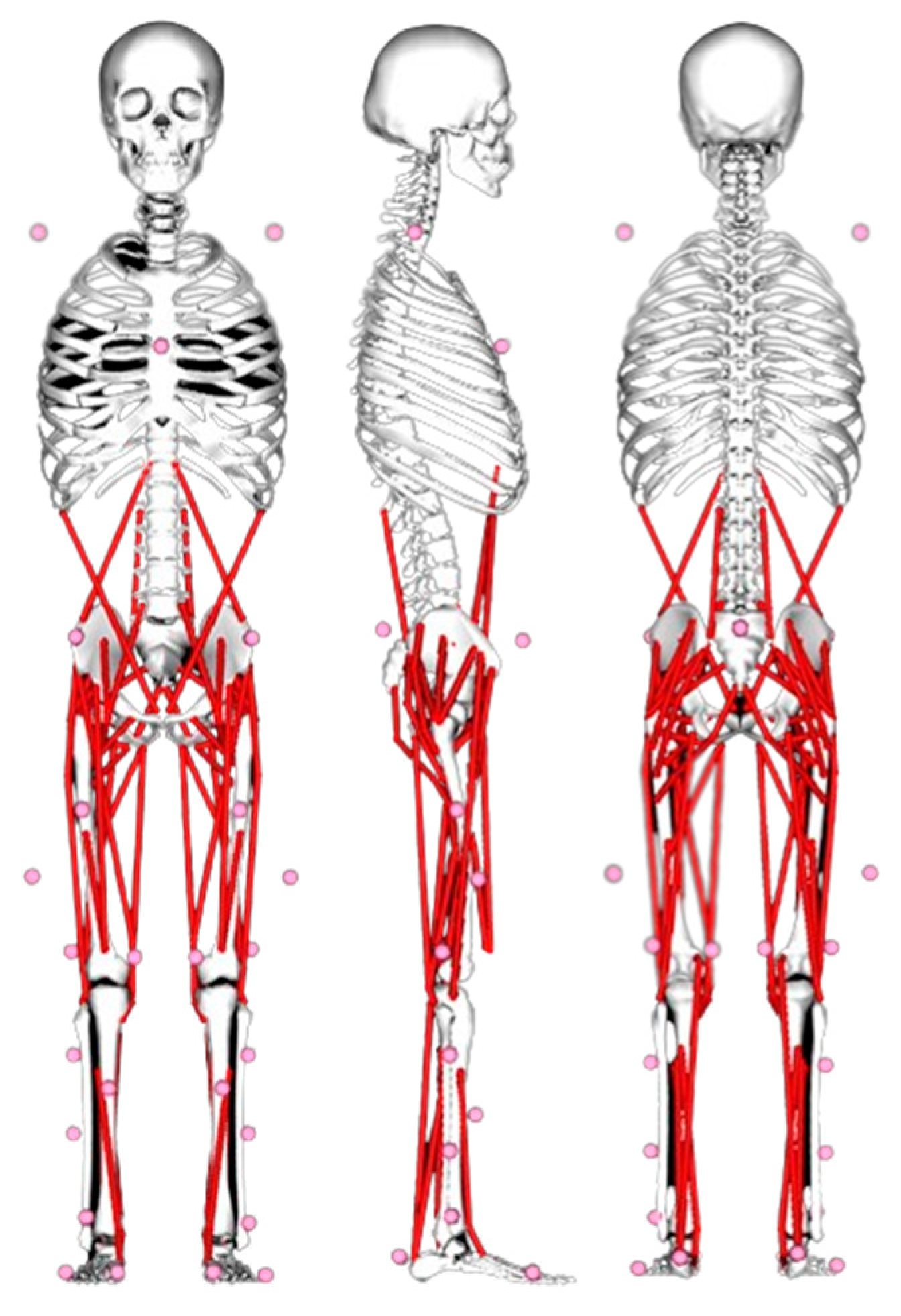
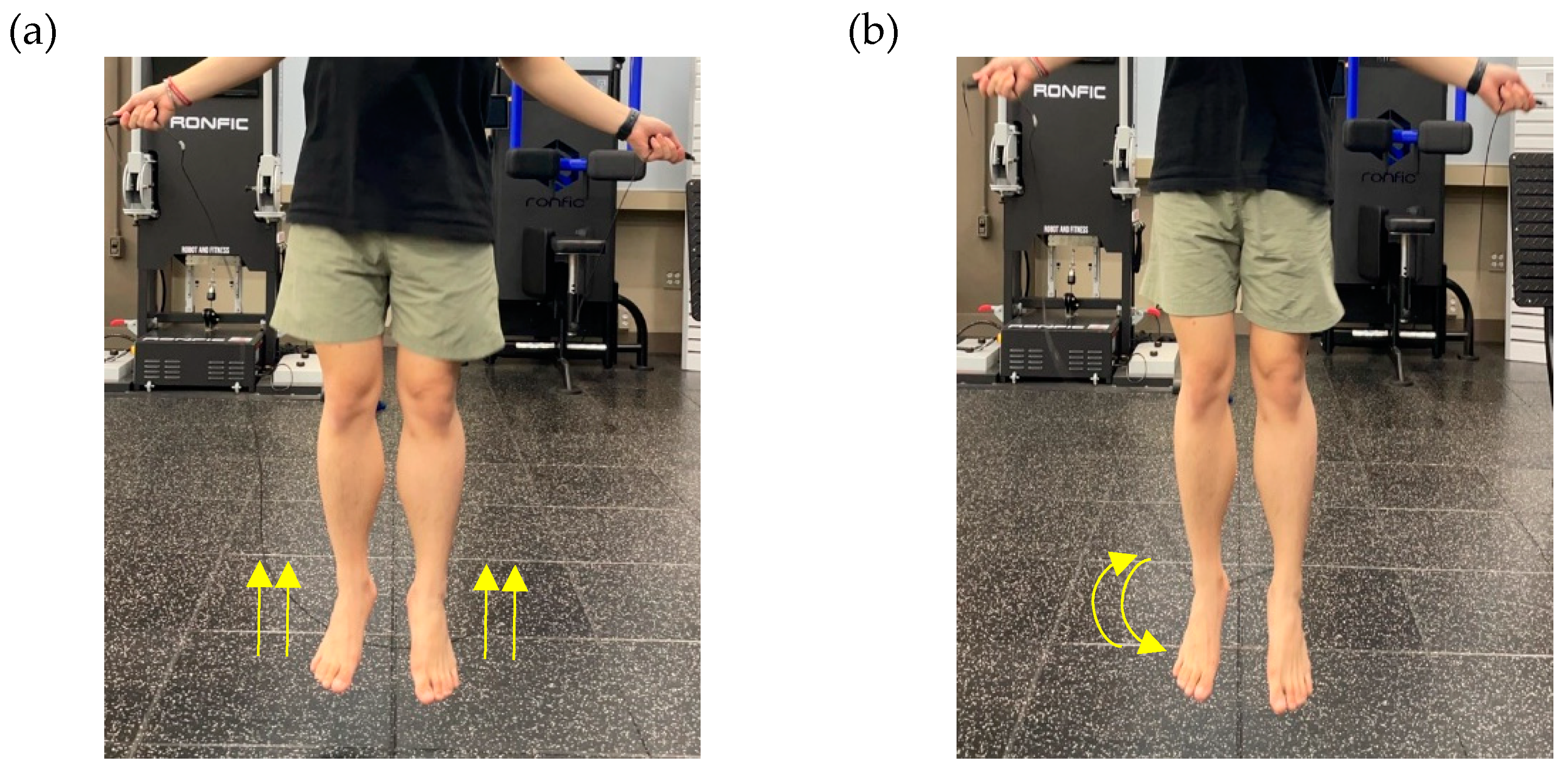
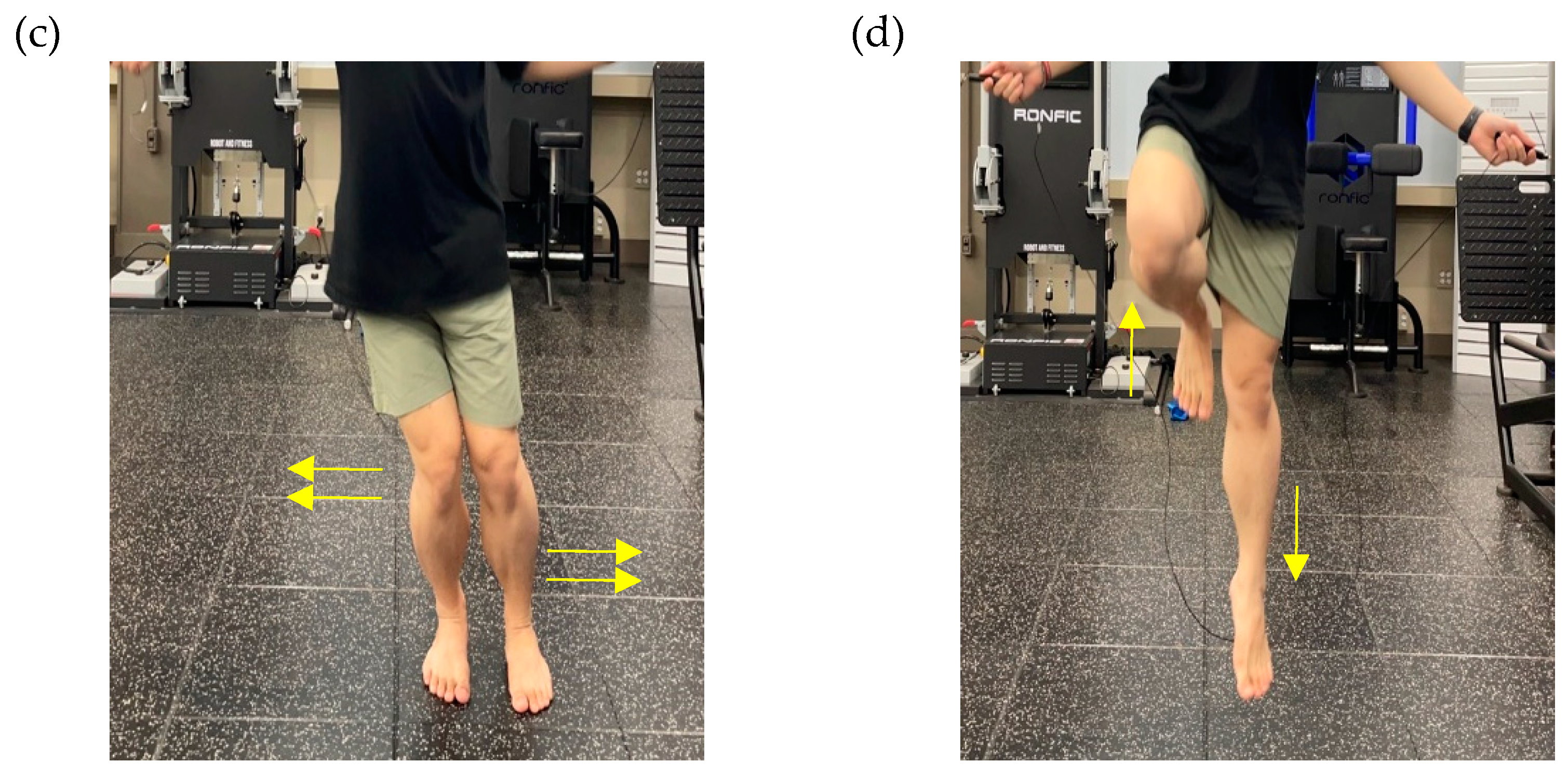
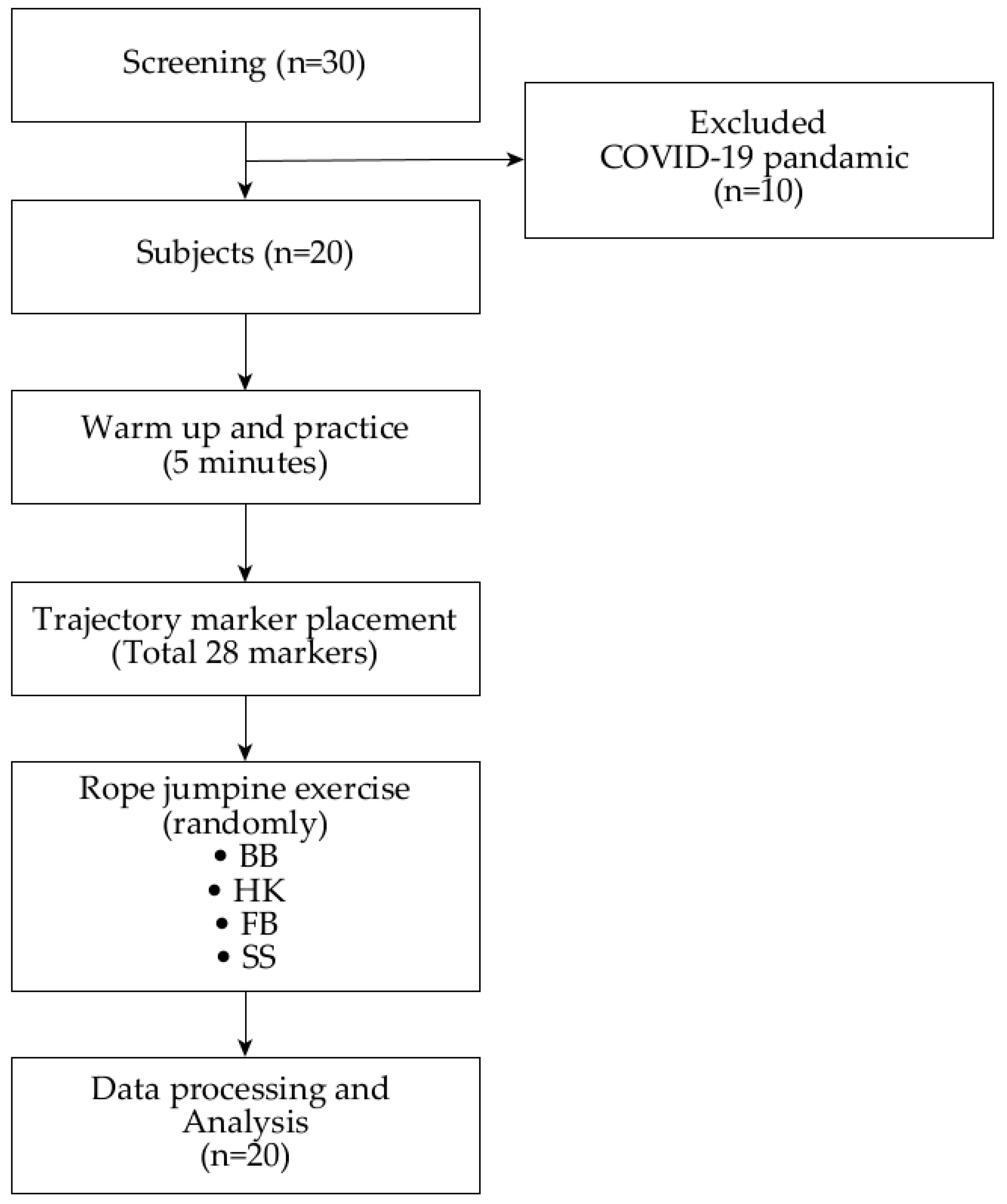
| n | Age (year) | Height (cm) | Weight (kg) | BMI (kg/m2) |
|---|---|---|---|---|
| 20 | 26.40±2.59 | 173.50±4.30 | 83.40±17.56 | 27.60±5.19 |
| BMI, Body Mass Index | ||||
| Jumping rope Techniques | Variables | IC | MKF | Statistical |
|---|---|---|---|---|
| BB | Knee flexion (degree) | 26.62 ± 9.65 | 37.98 ± 8.62 | < .05 |
| Knee extension moment (%BWm) | 1.60 ± 0.70 | 1.90 ± 0.60 | ||
| Knee joint GRF (%BW) | ||||
| Vertical | -110.23 ± 20.93 | -125.67 ± 21.88 | < .05 | |
| Anteroposterior | 14.59 ± 4.28 | 11.62 ± 3.37 | < .05 | |
| Mediolateral | 7.28 ± 12.93 | 7.17 ± 13.56 | ||
| Muscle forces (%BW) | ||||
| Quadriceps | 209.64 ± 42.71 | 396.94 ± 78.09 | < .05 | |
| Hamstring | 49.15 ± 43.11 | 53.94 ± 40.18 | ||
| HK | Knee flexion (degree) | 22.37 ± 3.67 | 31.59 ± 3.65 | < .05 |
| Knee extension moment (%BWm) | 1.11 ± 0.56 | 2.06 ± 0.64 | < .05 | |
| Knee joint GRF (%BW) | ||||
| Vertical | -118.78 ± 30.65 | -165.91 ± 37.60 | < .05 | |
| Anteroposterior | 18.02 ± 15.34 | 20.53 ± 18.93 | < .05 | |
| Mediolateral | 4.76 ± 8.99 | 3.96 ± 10.35 | ||
| Muscle forces (%BW) | ||||
| Quadriceps | 404.18 ± 55.05 | 530.50 ± 93.59 | < .05 | |
| Hamstring | 49.25 ± 35.06 | 54.47 ± 38.07 | ||
| FB | Knee flexion (degree) | 38.26 ± 9.70 | 45.85 ± 9.82 | < .05 |
| Knee extension moment (%BWm) | 1.11 ± 0.61 | 2.21 ± 0.53 | < .05 | |
| Knee joint GRF (%BW) | ||||
| Vertical | -122.88 ± 21.01 | -163.10 ± 22.69 | < .05 | |
| Anteroposterior | -8.70 ± 12.47 | -8.85 ± 13.02 | ||
| Mediolateral | 6.14 ± 9.82 | 7.33 ± 11.21 | ||
| Muscle forces (%BW) | ||||
| Quadriceps | 431.89 ± 59.05 | 537.34 ± 89.36 | < .05 | |
| Hamstring | 83.67 ± 38.02 | 98.19 ± 42.22 | ||
| SS | Knee flexion (degree) | 35.89 ± 9.11 | 47.27 ± 9.71 | < .05 |
| Knee extension moment (%BWm) | 1.98 ± 0.73 | 2.68 ± 0.67 | < .05 | |
| Knee joint GRF (%BW) | ||||
| Vertical | -114.63 ± 25.20 | -163.15 ± 31.25 | < .05 | |
| Anteroposterior | 21.13 ± 5.66 | 24.51 ± 12.23 | ||
| Mediolateral | -6.22 ± 13.01 | -8.31 ± 13.09 | ||
| Muscle forces (%BW) | ||||
| Quadriceps | 532.53 ± 88.47 | 601.59 ± 93.81 | < .05 | |
| Hamstring | 94.40 ± 48.44 | 105.11 ± 38.89 | ||
| BB, basic bounce; HK, high knee jumping rope; FB, Forward-backward jumping rope, SS, Side-to-side jumping rope; GRF, Ground reaction force; BW, Body weight; BWm, Body weight∙hegiht(meter) | ||||
| * The mean difference is significant at the p < .05 | ||||
| Variable | BB | HK | FB | SS | Post-hoc |
|---|---|---|---|---|---|
| Knee flexion (degree) | 32.30 ± 9.01 | 26.98 ± 3.25 | 42.05 ± 9.55 | 41.58 ± 9.21 | BB,HK<FB,SS |
| Knee extension moment (%BWm) | 1.75 ± 0.48 | 1.59 ± 0.48 | 1.66 ± 0.46 | 2.33 ± 0.55 | BB,HK,FB<SS |
| Knee joint GRF (%BW) | |||||
| Vertical | -117.95 ± 20.17 | -142.35 ± 33.47 | -142.99 ± 20.49 | -138.89 ± 27.84 | BB>HK,FB,SS |
| Anteroposterior | 13.10 ± 3.50 | 19.28 ± 16.97 | -8.77 ± 12.63 | 22.82 ± 7.70 | SS>BB,HK>FB |
| Mediolateral | 7.22 ± 13.20 | 4.36 ± 9.59 | 6.74 ± 9.03 | -7.26 ± 12.61 | BB,HK,FB>SS |
| Muscle forces (%BW) | |||||
| Quadriceps | 303.29 ± 57.23 | 467.34 ± 68.62 | 484.61 ± 68.84 | 567.06 ± 89.12 | BB<HK,FB<SS |
| Hamstring | 51.54 ± 41.64 | 51.86 ± 36.56 | 90.93 ± 40.12 | 95.75 ± 43.66 | BB,HK<FB,SS |
| BB, basic bounce; HK, high knee jumping rope; FB, Forward-backward jumping rope, SS, Side-to-side jumping rope; GRF, Ground reaction force; BW, Body weight; BWm, Body weight∙hegiht(meter) | |||||
| * The mean difference is significant at the p < .05 | |||||
Disclaimer/Publisher’s Note: The statements, opinions and data contained in all publications are solely those of the individual author(s) and contributor(s) and not of MDPI and/or the editor(s). MDPI and/or the editor(s) disclaim responsibility for any injury to people or property resulting from any ideas, methods, instructions or products referred to in the content. |
© 2023 by the authors. Licensee MDPI, Basel, Switzerland. This article is an open access article distributed under the terms and conditions of the Creative Commons Attribution (CC BY) license (http://creativecommons.org/licenses/by/4.0/).





